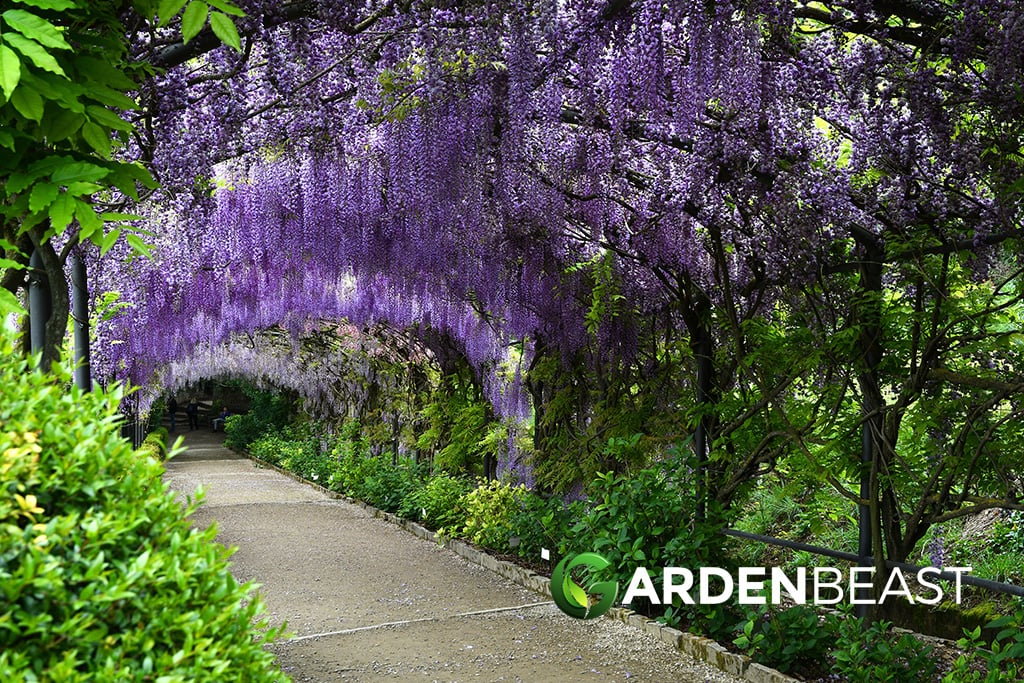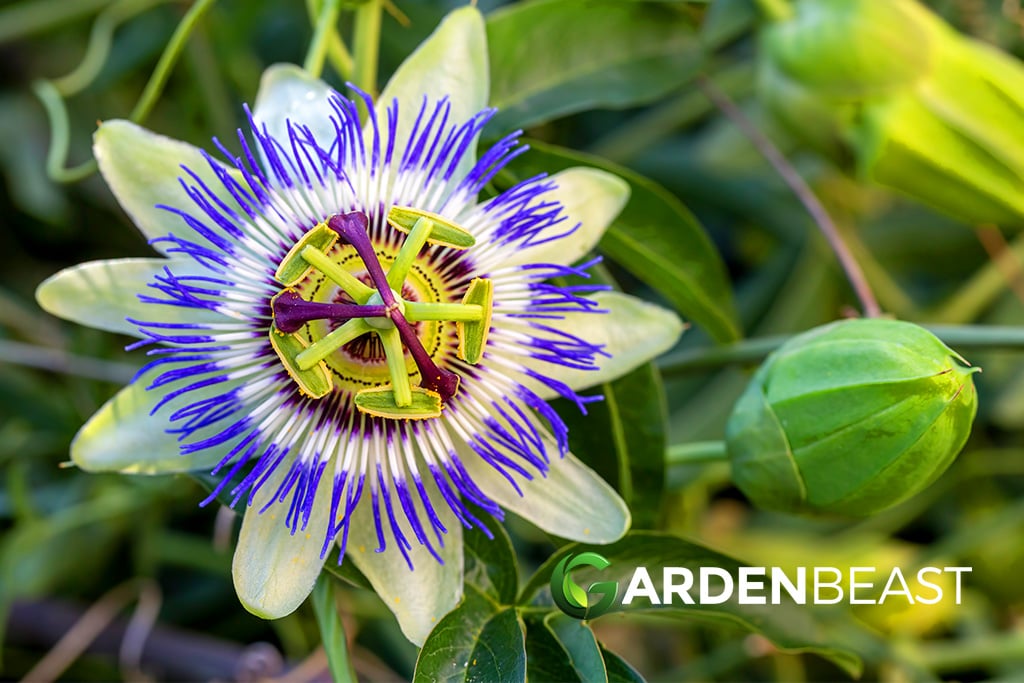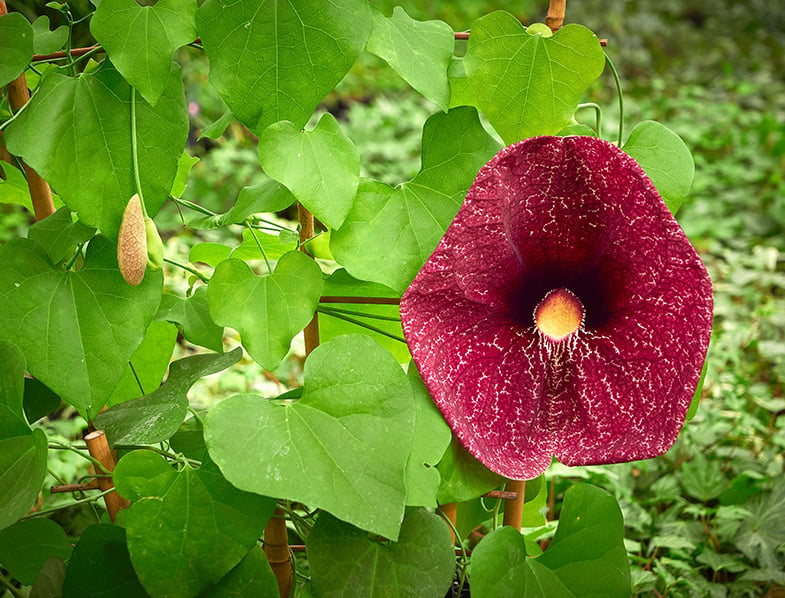Vines instantly add a very optimistic and romantic vibe to your garden. They make your garden feel more complete, and can help you cover up less attractive features like ugly walls.
Many wonderful vines are treasured primarily for their foliage, but gardeners in search of beautiful flowering vines have plenty of options — whether they are looking for vines that can act as ground cover plants, climbing vines, or trailing vines. Most flowering vines grow quickly and can be trained to grow on a trellis or along a wall without any problems.
Are you looking for the “best” flowering vines for your garden? Writing a guide that tells you exactly which ones can get this seal of approval is a tall order — you’ll find countless different options, whether you’re hoping to grow flowering vines in sunny or shady spots, and regardless of your local climate.
All of the gorgeous flowering vines on this list earned their spot for a specific reason, though, and we’re sure at least one of them can work its way into your heart (and, of course, your garden), too.
Adding Vining Plants to Your Garden: A Short Guide
Climbing vines are a wonderful way to add character to any garden. People who are working with tiny gardens can make artful use of flowering vines to add vertical appeal, creating a whimsical oasis that can easily look like it’s much bigger than it actually is. In larger gardens, climbing flowering vines may be used to cover up unsightly areas such as bare walls or boring garden sheds.
Climbing vines are a must in any privacy garden, and if you have the space, there is absolutely nothing better than growing a dense vine with beautiful flowers on a trellis or arbor for that wonderful cottage garden look.
(No matter how wonderful it looks, never allow vines to grow on trees, though, as this often robs trees of nutrients and sunlight.)
Before you fall in love with a particular flowering vine, though, keep in mind that every plant has unique care requirements:
- Many flowering vines can survive perfectly fine in shady conditions, but will sadly not bloom as abundantly, if at all. Gardeners who would like to enjoy pretty vertical flowers in the shade will need to keep an eye out for flowering vines that are shade-tolerant.
- Some vines can emerge to be creepers or climbers, and will expand horizontally unless they are given a vertical support system to climb up. This can occasionally “drown out” smaller garden plants, so gardeners will want to be vigilant.
- Creeping vines make for excellent ground cover plants, which help with erosion control. Everyone loves climbing vines, but don’t overlook the potential for creeping vines to make your garden come to life with attractive flowers while also meeting this particular need.
- Some vines are either outright invasive (a term that’s only applied to plants that aren’t native to a particular area) or rather aggressive, which simply means that they’re voracious growers. Those who may get into trouble with their neighbors or a HOA may prefer to add vines that don’t grow quite as quickly to their gardens.
- As with all plants, gardeners will need to ascertain that they can provide the right set of cultural conditions for any vine they add to their garden.
With those basic tips out of the way, you’re ready to see which amazing flowering vines have made it onto the list, right? Let’s dive in!

Canary Creeper (Tropaeolum Peregrinum)
The canary creeper vine, scientifically called Tropaeolum Peregrinum, has an awful lot going for it. This is a vine with a dainty and highly-textured look that gives rise to spectacular canary-yellow flowers that are not just showy up close, but can be spotted from a distance, too.
The blooms emerge in spring and can last through summer and even well into the fall, bringing pollinators and butterflies to your green oasis, too. The only drawback? This vine wasn’t named for its bright yellow flowers, but for its region of origin — the Canary Islands. That means it’s a tropical vine, and it cannot be grown in every region.
Before you add a canary creeper vine to your garden, see if you can meet this gorgeous plant’s needs:
- Canary creepers can grow to be up to 12 feet (three meters) tall, with a spread of up to two feet (just over half a meter).
- These vines need full sun to thrive, as well as summer temperatures of at least 70 °F (21 °C). As tropical vines, canary creepers additionally do best in humid conditions.
- Canary creepers don’t have holdfasts, so ambitious gardeners who would like to grow them on a trellis or arbor will need to tie these vines in place.
- Like many tropical plants, canary creepers prefer slightly drier soil conditions.
- Do your bit to keep your canary creeper, which is grown as an annual, healthy by adding some natural compost to its soil. These vines do not need fertilizer and don’t especially like it.
- All parts of this vine are edible, with a very pleasantly refreshing sour taste. That makes the canary creeper a great choice for your edible garden.

Black-Eyed Susan (Thunbergia Alata)
Black-eyed Susan (Thunbergia alata) is another delightful tropical vine that’s usually grown as an annual.
Their beautiful orange to salmon colored and trumpet-shaped flowers, which are flanked by bracts, last through summer and into the fall. While it’s sometimes grown on trellises, black-eyed Susan has a beautiful trailing growth habit and will look its best in a hanging basket. If you’re looking for a ground cover plant, black-eyed Susan can help you out with this, too.
These unquestionably gorgeous vines:
- Grow to be eight feet (two meters) tall or long, depending on how you train the plant, and have a wide spread as well.
- Can perform well in either full sun or partial shade, but to encourage abundant blooms, it’s best to make sure this vine gets at least six hours of daily sun.
- Need a very rich soil with good drainage, preferring a neutral pH level.
- Will thank you if you can keep their soil evenly moist but never soggy.
- Are perennials, but can be grown as annuals without any trouble in slightly cooler areas.
- Require a complete fertilizer to look their best.

Climbing hydrangea (Hydrangea Anomala Petiolaris)
These absolutely gorgeous trailing vines are often grown on walls and fences, and their pretty clusters of flowers will definitely stand out in any garden! The climbing hydrangea is native to Asia and is part of the Hydrangeaceae family. They can often grow to be 30 to 50 feet (nine to 15 meters) tall and develop a nice spread of five to six feet (one and a half to two meters) wide. They come with charming green foliage and amazing clusters of delicate white flowers!
Want to liven up your garden with a climbing hydrangea? Before you pick one up for yourself, keep in mind that:
- Climbing hydrangea thrive in moist conditions— the name hydrangea literally means “water vessel” in Greek! This vine will need around an inch of water each week, and the climbing hydrangea can usually get this from rainfall, but if you live in a dry area, you will need to water it yourself.
- This flowering vine will do best in a nutrient rich and well-draining soil. An acidic pH level is good for the climbing hydrangea, though it isn’t that picky about pH levels.
- You should plant your climbing hydrangea in a spot where it can receive either partial shade or full sunlight. Unlike a lot of other flowering vines, climbing hydrangea vines can do pretty well in shadier conditions and will still flower.
- When it comes to the ideal temperature for this vine, climbing hydrangea prospers in more temperate climates. They certainly don’t like humid and warm climates which can, in fact, damage the climbing hydrangea.

Chocolate Vine (Akebia quinata)
The chocolate vine, also called the five-leaf Akebia or the raisin vine and scientifically known as Akebia quinata, hails from East Asia and has an amazing twining growth habit. With woody stems and lush green elliptical leaves, which can be deciduous or evergreen, these vines also produce delicate deep purple to crimson flowers in spring. If you envision a fragrant garden, the chocolate vine likely deserves a spot in it; the flowers have a sweet spicy flavor, and also attract songbirds.
Ready to plant one in your garden? Hang on a moment — familiarize yourself with the conditions the chocolate vine needs to thrive first!
- Chocolate vines can grow to be around 30 feet (10 meters) long, with a modest spread of two feet (just over half a meter).
- These vines have absolutely no trouble with partial shade. Since you’re after flowering vines, though, you should know that you’ll get the most abundant bloom if your chocolate vine gets at least six hours of direct sun each day.
- Chocolate vines are not too picky about their soil, but rich sandy or loamy soil is a great choice.
- Since these vines come from a more temperate region (preferring temperatures between 55 and 85 °F, or 13 to 30 °C), they can survive periods of mild drought. Water your chocolate vine whenever the topsoil dries out.
- Chocolate vines produce black to purple fruits, which are small but edible. These fruits taste a bit like melon.
- They’re uniquely disease resistant, making chocolate vines a great choice for beginning gardeners.
- These vines will climb up any surface quickly, and their twining growth habit is the most attractive feature — besides the pretty flowers, of course.
Chocolate vines are fast growers that will need to be pruned often to keep them under control.

Chinese Wisteria (Wisteria Sinensis)
The Chinese wisteria will grant you with majestic large blooms of purple flowers which are also very fragrant! This attractive flowering vine is one of many different species in the Wisteria genus, and as the name suggests, is native to China. Chinese wisteria is unique compared to other wisteria in the fact that it’s very long lasting and can even survive up to 100 years!
Looking to brighten up your garden with mesmerizing purple blooms? Wait! The Chinese wisteria is a high-maintenance plant, and before getting one, you should know what you’re getting yourself into:
- Young Chinese wisteria vines will need regular and deep watering to help them develop properly, but do make sure that you don’t overwater your young vines. Mature plants will typically get most of their water from rainfall, though they will still need to be watered around once a week if there hasn’t been much rain. Wisteria can even survive shorter periods of drought.
- Chinese wisteria will reward you with gorgeous blooms if you place it in a spot where it can get partial to full sunlight — ideally getting around six hours of direct sunlight. Though most wisteria plants hate shade, this species won’t mind a bit of shade, making it an especially great option for gardeners who’d love flowering vines in the shady areas of their gardens.
- A well-draining soil mixed with hummus will be great for a Chinese wisteria. For soil pH levels, Chinese wisterias do best in slightly acidic soil. Because Chinese wisteria won’t do well when moved around, be sure to get the soil right!
- Chinese wisteria plants do best in humid climates but can also sometimes grow in drier climates, as long as the soil is kept moist. These flowering vines can also survive cold temperatures but their buds could when kept in freezing climates for too long.
- One of the reasons the Chinese wisteria is considered to be hard to take care of is because it requires frequent pruning. Pruning your Chinese wisteria will help keep it in good shape, and if not pruned this fast growing plant could get out of hand very quickly.
- Pet owners may want to know that the Chinese wisteria is toxic to both cats and dogs. This vine is also slightly toxic to humans when any part of it is eaten.
- You may be excited to gaze at the pretty blooms of the Chinese wisteria, but it will only produce flowers when fully mature. It could take up to 20 years for this vine to fully mature, so be patient!

Climbing Snapdragon (Maurandya Scandens)
Are you in search of a flowering vine with fragrant and beautiful, but modestly-sized, purple flowers? Look no further than the climbing snapdragon, also sometimes called the creeping or trailing snapdragon and scientifically known as Maurandya scandens.
This vine offers delicate arrow-shaped foliage, which has a fresh green shade, and are famous for climbing up a trellis in no time at all, quickly forming a dense cover. Climbing snapdragons also act as hummingbird magnets, so if you’re lucky enough to live in the right region, you’ll be able to feast your eyes on more than the vine alone.
The climbing snapdragon:
- Is an exceptionally fast grower that will soon reach a height of nine feet (nearly three meters), with an equally impressive spread.
- As the delicate look of this vine may already suggests, the climbing snapdragon is a wonderful choice for gardeners who are looking for flowering vines that can thrive in partial shade. Give this vine morning sun and afternoon shade, and it’ll stay healthy.
- Climbing snapdragon vines can grow in a variety of soil conditions and will do fine in a rich soil.
- While climbing snapdragon vines appreciate regular supplemental watering, it is important that their soil does not become soggy. This places your beautiful vine at a high risk of developing root rot, which would be a great shame.
- Help this vine along with a complete fertilizer regime during its growing phase.
- As a nice bonus, climbing snapdragons won’t need much, if any, pruning.
Purple Passionflower Vine (Passiflora)
True — the purple passionflower’s blooms are rather short-lived, which doesn’t make these vines a very good choice for gardeners who are hoping to enjoying flowering vines throughout the year. Those gardeners who appreciate the unique transient beauty of the passionflower, and those who are eager to enjoy its edible fruits, may want to add a purple passionflower vine to their gardens anyway.
Although purple passionflower vines are tropical plants (they mainly originate from South America), it’s possible to grow these unique flowering fines in more temperate and northern regions, as well. They’ll need:
- Full sun, or at least six hours of sun exposure each day, if they are growing in more temperate climates. In warmer areas, where the sun gets scorching hot, purple passionflower vines do appreciate some nice afternoon sun.
- A soil high in organic matter, with a neutral to slightly acidic pH level.
- Regular fertilizer, and a balanced program is the best choice. You can supplement this with natural compost to keep your purple passionflowers looking healthy.
- To be placed in a spot on your garden where these vines are sheltered from strong winds, which can damage them.
Purple passionflower vines aren’t frost hardy, but if you live in a colder region, it is still possible to grow these vines in a container or large planter and to bring them indoors to overwinter.

Star Jasmine (Trachelospermum Jasminoides)
A multitude of creamy little star-shaped flowers, which are also fragrant? Check. Evergreen leaves that will never get dull? Check. Sprawling vine that will soon take over an entire flowerbed? Check! Pollinator magnet? Check again!
There’s very little to hate about this flowering vine, which does a great job of proving that not all tiny flowers have to earn themselves the unfortunate label of “insignificant”, so long as there are enough of them. The only downside, if you can call it that, is the fact that the star jasmine isn’t frost tolerant. That’s easily solved by growing star jasmine vines in containers, and then bringing them inside for the winter. If you’d prefer, it’s also possible to grow these vines as a houseplant 100 percent of the time.
Might the star jasmine vine be right for your garden? Check this star jasmine care 101 before you bring one home:
- You already know the drill — like many other flowering vines, star jasmine vines don’t mind shady conditions but will reward you with the maximum number of flowers if you offer them full sun exposure (at least six hours a day).
- These plants are extremely forgiving when it comes to soil conditions, and can grow well in almost any soil, with almost any pH level. Just make sure it’s well-draining, because you don’t want root rot.
- For the best results, your garden should maintain temperatures ranging from 60 to 75 °F (16 to 14 °C).
- Only fertilize mature star jasmine vines, with a balanced slow-release fertilizer.

Dutchman’s Pipe (Aristolochia Macrophylla)
Also called wild ginger, Dutchman’s pipe is a highly poisonous climbing vine best known for its wonderfully dense and fresh green foliage, which is heart-shaped and has a silvery shade on its underside. This vine gets its unique name from the fact that the delicate and small flowers, which are yellow and white, look somewhat like a smoking pipe. Though the flowers are often hidden behind the dense leaves, they look playful and interesting.
In addition, this flowering vine — which needs full sun or partial shade and appreciates slightly moist loamy soil — has the quality of attracting rare butterflies.

In Conclusion
Gardeners have so many unique flowering vines to choose from — and, inevitably, a finite amount of space — that it is always hard to choose which ones deserve a spot in the garden. The best flowering vines are those you can grow and care for in your climate, and that put a smile on your face every time you set foot in the garden. Hopefully, some of these gorgeous vines will make it onto your personal shortlist!

1 Comment
Hallo beautiful flower vines how to purchase them I want for my farmhouse please suggest
With warm regards
Vijaya vani